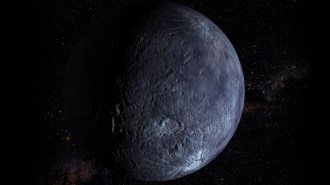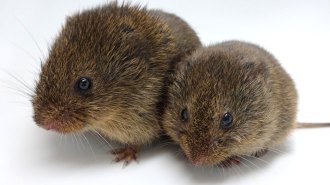Search Results

This Dwarf Planet Hosts an Odd Ring
In science, the exceptions offer researchers a chance to think differently about a concept they thought they understood. In this Guide, students will learn how astronomers use a concept called the Roche limit and how a ring around a dwarf planet does not follow the Roche limit rules.
Why doesn’t this dwarf planet follow the rules about rings?
Students will answer questions about the online Science News article “The Kuiper Belt’s dwarf planet Quaoar hosts an impossible ring,” which describes a recent astronomical discovery that is completely counter to what scientists expected to see. A version of the article, “This dwarf planet hosts an odd ring,” appears in the March 11, 2023 issue of Science News.
Defining and defying Roche limits
Students will review force diagrams and gravitational force and discuss planetary ring and moon formation using the concept of the Roche limit.
Learning Outcomes: Applying gravitational forces and interactions in space to understand ring and moon formation.
Vibration check
Most of us drive across bridges every day and never question their structural integrity. We trust that the bridge will stand. In this activity, students will study a famous bridge collapse and consider how it could have been prevented. They also will learn how engineers are testing whether crowdsourced cell phone data could be used to determine when bridges need repairs. Using simulated data of bridge vibration frequencies, students will identify whether an imaginary bridge might be unstable. Students have the option of creating model bridges and testing their structural integrity.
Curbing Climate Change
The emissions of greenhouse gases through human activities are changing the world and making it warmer. But there are technologies and strategies that can reduce these emissions and slow climate change. In this activity, students will research methods of reducing carbon dioxide production and removing carbon from the atmosphere and present on their findings.

Voles Don’t Need Oxytocin to Bond
Scientists thought the “love hormone” oxytocin was required to help animals form social bonds. In this Guide, students will learn how a study using a gene-editing tool called CRISPR is questioning that perspective — at least for prairie voles.
CRISPR Explained
Students will learn how CRISPR gene-editing technology works and discuss its applications and its importance to research.
Learning Outcomes: Learning about CRISPR and why it is an important technology
Prairie voles can couple up even without the ‘love hormone
Students will answer questions about the online Science News article “Prairie voles can find partners just fine without the ‘love hormone’ oxytocin,” which explores how scientists upended a common understanding of the hormone by using CRISPR technology. A version of the article “Voles don’t need oxytocin to bond” appears in the February 25, 2023 issue of Science News.
The Past, Present and Future of Spaceflight
Have you ever wondered how the people who get to fly in space are chosen? The path to becoming an astronaut has changed a lot over the years. In this activity, students will learn about the space travelers of the past and present — and consider a future where the diversity of astronauts better reflects the diversity of all of humankind. Students will use their creative writing skills to imagine this future.
Fermentation and Pasteurization in the classroom
The multitalented Louis Pasteur was a chemist, biologist, the father of microbiology and the inventor of pasteurization. In this hands-on lab, students will learn about Pasteur’s contributions by conducting an inquiry-based yeast fermentation experiment that explores the concept of pasteurization. In this experiment, students will observe, calculate and graph the volume of carbon dioxide produced by yeast during fermentation at different temperatures and identify the point where the yeast have been killed and pasteurization occurs.

Chemists Crack the Code to Ancient Roman Concrete
The ancient Romans built concrete structures that have stood for thousands of years. In this Guide, students will learn how scientists experimented to make Roman-style concrete — without causing explosions!
Concrete physical and chemical changes
Use a real-life example to give students a deeper understanding of physical and chemical changes and properties of substances.